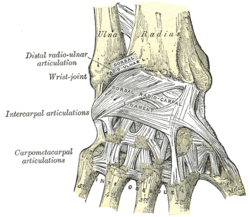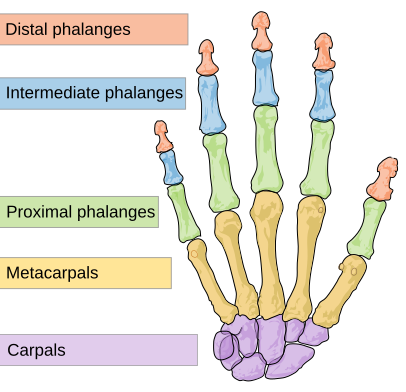- 1) the power grip, in which the object is held between the surface of the partly flexed fingers and the palm, with the thumb acting as reinforcing agent; and
- 2) the precision grip, in which the object is pinched between the tips of the fingers and the opposed thumb.
페이지
2009년 3월 31일 화요일
Grip Types and Manual Laterality for Picking up
Saddle joint
| Saddle joint | |
|---|---|
| 1: Ball and socket joint; 2: Condyloid joint (Ellipsoid);3: Saddle joint; 4 Hinge joint; 5: Pivot joint; | |
| Ligaments of wrist. Posterior view. | |
| Latin | articulatio sellaris |
| Gray's | subject #70 286 |
In a saddle joint (sellar joint, articulation by reciprocal reception) the opposing surfaces are reciprocally concave-convex.
Contents[show] |
[edit]Movements
The movements are the same as in a condyloid joint; that is to say, flexion, extension,adduction, abduction, and circumduction are allowed; but no axial rotation.
[edit]Examples
The best example of this form is the carpometacarpal joint of the thumb.[1]
[edit]References
[edit]External links
| This musculoskeletal system article is a stub. You can help Wikipedia by expanding it. |
The Hand (Introduction for Teachers)
- When you picked up a large cylindrical object, such as a can or bottle, you are using what is called the "power grip." The cushion of the palm fits tightly against the object, the four fingers curl around it in one direction, and the thumb hooks around in the other direction. With this grip you can squeeze the object and hold it very firmly. We use the power grip to pound with a hammer, swing a baseball bat, and hold a jar of peanut butter while unscrewing the cap with the other hand.
- The grip used to pick up a coin is called the "precision grip." The hand acts like a vise or clamp in the power grip. In the precision grip the tip of the thumb closes on the tip of the forefinger or middle finger like the jaws of a pair of pliers or the prongs of a pair of forceps. Fine control, not power, is the name of the game. See the transparency that shows both the power grip and the precision grip. Early hominids used the precision grip to make tools and to glean and pick fruits, seeds, nuts, and insect grubs that made up a large part of their diet.
- Some biologists believe that there is a third important grip. It can be called, for lack of a better name, the "chuck-grip." Flex your palm and bring your thumb against the tips of the four fingers of the hand. If you look directly at your fingers in this position, you will see that the arrangement resembles the jaws of a drill chuck. When you hold a roughly spherical object like a stone – or a baseball – your fingers and thumb are spread around the object in a chuck grip. Early hominids probably used the chuck grip to throw stones at predators, prey, and rival groups of hominids.
The Handyman Who Wasn't
.jpg)
자료(Source): http://www.i170.com/attach/C908927D-B011-47FD-87D6-4ADF5A3067B6
- the joint surfaces in humans allow us to round our hands and cup objects.
- Chimps cannot cup their hands like a human can. Their fingers are designed for gripping tree branches, not pitching a baseball.
- Humans can also pinch objects tightly between the thumb and the side of the index finger, the way you would hold a key while unlocking a door.
- Chimps and gorillas do not have this strong “pad-to-side” grip.
손은 왜 존재하는가
2009년 3월 30일 월요일
인류의 진화와 발전을 가져온 손
trapezium (큰마름뼈)
The trapezium bone (greater multangular bone) is a carpal bone, in what is commonly referred to as the wrist.
The trapezium is distinguished by a deep groove on its palmar surface. It is situated at the radial side of the carpus, between the scaphoid and {the first metacarpal bone; 엄지 손가락에 이어지는 손바닥(손허리뼈)}.
The etymology derives from the Greek trapezionwhich means "irregular quadrilateral;" literally, "a little table," from trapeza meaning table. Also, fromtra- "four" and peza "foot" or "edge."
Contents[hide] |
Surfaces
The superior surface is directed upward and medialward; medially it is smooth, and articulates with the scaphoid; laterally it is rough and continuous with the lateral surface.
The inferior surface is oval, concave from side to side, convex from before backward, so as to form a saddle-shaped surface for articulation with the base of the first metacarpal bone.
The dorsal surface is rough.
The palmar surface is narrow and rough. At its upper part is a deep groove, running from above obliquely downward and medialward; it transmits the tendon of the Flexor carpi radialis, and is bounded laterally by an oblique ridge. This surface gives origin to the Opponens pollicis and to theAbductor and Flexor pollicis brevis; it also affords attachment to the transverse carpal ligament.
The lateral surface is broad and rough, for the attachment of ligaments.
The medial surface presents two facets; the upper, large and concave, articulates with thetrapezoid; the lower, small and oval, with the base of the second metacarpal.
Tubercle of trapezium
The tubercle of trapezium is a anatomic tubercle, where sometimes abductor pollicis brevis muscle attaches.
See also
손, 손바닥, 손목 부위 골격 용어 (일부)
- carpus: 손목, 손목뼈, 수근골(手根骨)
- metacarpus: 손허리, 손바닥뼈, 중수(中手), 중수골(中手骨)
- metacarpal bone : 손허리뼈, 중수골(中手骨)
- trapezium : 큰마름뼈, 큰마름골, 대능형골(大菱形骨).
- trapezio(-)metacarpal: pertaining to or connecting the trapezium(손목 큰마름뼈) and the metacarpus(손바닥뼈).
- cf. trapezio(-)metacarpal joint, temporomandibular joint: 의학약어로 TMJ로 불림.
| Bone: Carpals | |
|---|---|
| BONES OF HAND Proximal: A=Scaphoid, B=Lunate, C=Triquetral, D=Pisiform Distal: E=Trapezium, F=Trapezoid, G=Capitate, H=Hamate | |
| Latin | ossa carpi |
| Gray's | subject #54 221 |
| MeSH | Carpal+Bones |
| Dorlands / Elsevier | Carpus |
In tetrapods, the carpals is the sole cluster of the bones in the wrist between the radius and ulna and the metacarpus.
- The bones of the carpus do not belong to individual fingers (or toes in quadrupeds),
- whereas those of the metacarpus do. The corresponding part of the foot is the tarsus.
In crustaceans, "carpus" is the scientific term for the claws or "pincers" present on some legs.
Contents[hide] |
Variations
In some macropods, the scaphoid and lunar bones are fused into the scaphollunar bone.[1]
metacarpus
| Bone: Metacarpals | |
|---|---|
| The five metacarpal bones, numbered. | |
| Multiple fractures of the metacarpals (aka broken hand). |
The metacarpus is the intermediate part of the handskeleton that is located between the phalanges(bones of the fingers) distally and the carpus which forms the connection to the forearm. The metacarpus consists of metacarpal bones.
Contents[hide] |
Common characteristics of the metacarpal bones
Each consists of a body and two extremities.
Body
The body (corpus; shaft) is prismoid in form, and curved, so as to be convex in the longitudinal direction behind, concave in front.
It presents three surfaces: medial, lateral, and dorsal.
- The medial and lateral surfaces are concave, for the attachment of the interosseus muscles, and separated from one another by a prominent anterior ridge.
- The dorsal surface presents in its distal two-thirds a smooth, triangular, flattened area which is covered in by the tendons of the Extensor muscles. This surface is bounded by two lines, which commence in small tubercles situated on either side of the digital extremity, and, passing upward, converge and meet some distance above the center of the bone and form a ridge which runs along the rest of the dorsal surface to the carpal extremity. This ridge separates two sloping surfaces for the attachment of the Interossei dorsales.
To the tubercles on the digital extremities are attached the collateral ligaments of themetacarpophalangeal joints.
Base
The base or carpal extremity (basis) is of a cuboidal form, and broader behind than in front: it articulates with the carpus, and with the adjoining metacarpal bones; its dorsal and volar surfaces are rough, for the attachment of ligaments.
Head
The head or digital extremity (capitulum) presents an oblong surface markedly convex from before backward, less so transversely, and flattened from side to side; it articulates with the proximal phalanx.
It is broader, and extends farther upward, on the volar than on the dorsal aspect, and is longer in the antero-posterior than in the transverse diameter.
On either side of the head is a tubercle for the attachment of the collateral ligament of the metacarpophalangeal joint.
The dorsal surface, broad and flat, supports the tendons of the extensor muscles; the volar surface is grooved in the middle line for the passage of the Flexor tendons, and marked on either side by an articular eminence continuous with the terminal articular surface.
Articulations
Besides their phalangeal articulations, the metacarpal bones articulate as follows:
- the first with the trapezium;
- the second with the trapezium, trapezoid, capitate and third metacarpal;
- the third with the capitate and second and fourth metacarpals;
- the fourth with the capitate, hamate, and third and fifth metacarpals;
- and the fifth with the hamate and fourth metacarpal.
See also
- Bone terminology
- Boxer's fracture
- Terms for anatomical location
Carpometacarpal bossing
Additional images
This article was originally based on an entry from a public domain edition of Gray's Anatomy. As such, some of the information contained herein may be outdated. Please edit the article if this is the case, and feel free to remove this notice when it is no longer relevant.













